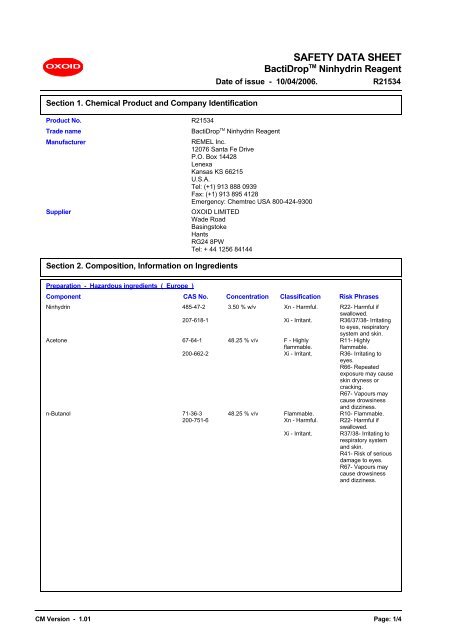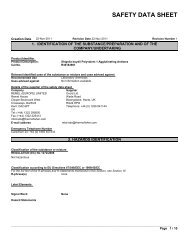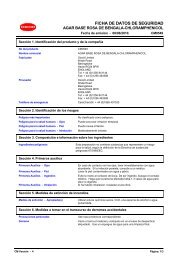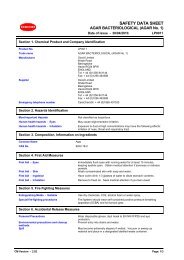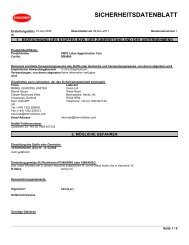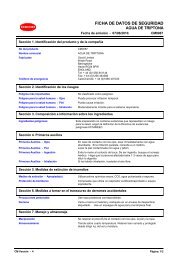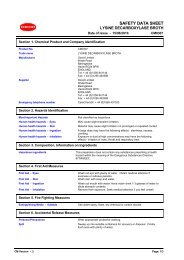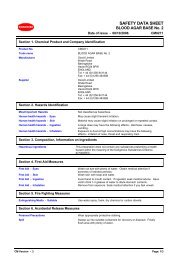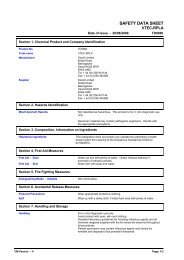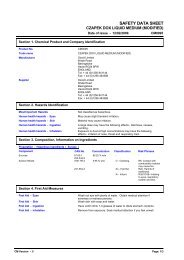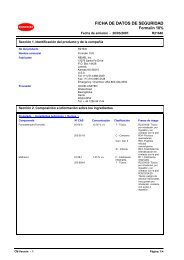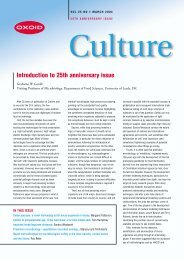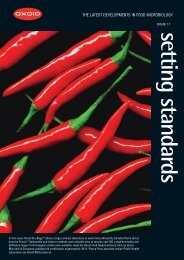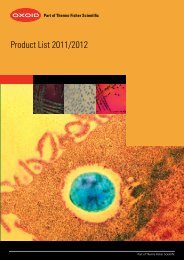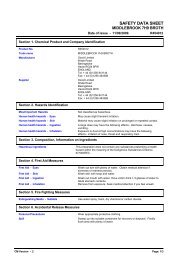MSDS - Remel Inc (Lenexa) - Oxoid
MSDS - Remel Inc (Lenexa) - Oxoid
MSDS - Remel Inc (Lenexa) - Oxoid
Create successful ePaper yourself
Turn your PDF publications into a flip-book with our unique Google optimized e-Paper software.
Section 1. Chemical Product and Company Identification<br />
Product No.<br />
Trade name<br />
Manufacturer<br />
R21534<br />
BactiDrop TM Ninhydrin Reagent<br />
BactiDropTM SAFETY DATA SHEET<br />
Ninhydrin Reagent<br />
Date of issue - 10/04/2006.<br />
REMEL <strong>Inc</strong>.<br />
12076 Santa Fe Drive<br />
P.O. Box 14428<br />
<strong>Lenexa</strong><br />
Kansas KS 66215<br />
U.S.A.<br />
Tel: (+1) 913 888 0939<br />
Fax: (+1) 913 895 4128<br />
Emergency: Chemtrec USA 800-424-9300<br />
Supplier OXOID LIMITED<br />
Wade Road<br />
Basingstoke<br />
Hants<br />
RG24 8PW<br />
Tel: + 44 1256 84144<br />
Section 2. Composition, Information on Ingredients<br />
Preparation - Hazardous ingredients ( Europe )<br />
Component CAS No. Concentration Classification Risk Phrases<br />
Ninhydrin 485-47-2<br />
207-618-1<br />
Acetone 67-64-1<br />
200-662-2<br />
n-Butanol 71-36-3<br />
200-751-6<br />
CM Version - 1.01<br />
3.50 % w/v Xn - Harmful.<br />
Xi - Irritant.<br />
48.25 % v/v F - Highly<br />
flammable.<br />
Xi - Irritant.<br />
48.25 % v/v Flammable.<br />
Xn - Harmful.<br />
Xi - Irritant.<br />
R21534<br />
R22- Harmful if<br />
swallowed.<br />
R36/37/38- Irritating<br />
to eyes, respiratory<br />
system and skin.<br />
R11- Highly<br />
flammable.<br />
R36- Irritating to<br />
eyes.<br />
R66- Repeated<br />
exposure may cause<br />
skin dryness or<br />
cracking.<br />
R67- Vapours may<br />
cause drowsiness<br />
and dizziness.<br />
R10- Flammable.<br />
R22- Harmful if<br />
swallowed.<br />
R37/38- Irritating to<br />
respiratory system<br />
and skin.<br />
R41- Risk of serious<br />
damage to eyes.<br />
R67- Vapours may<br />
cause drowsiness<br />
and dizziness.<br />
Page: 1/4
Section 3. Hazards Identification<br />
Most Important Hazards<br />
Human health hazards - Eyes<br />
Human health hazards - Skin<br />
Human health hazards - Ingestion<br />
Human health hazards - Inhalation<br />
Section 4. First Aid Measures<br />
First Aid - Eyes<br />
First Aid - Skin<br />
BactiDropTM SAFETY DATA SHEET<br />
Ninhydrin Reagent<br />
Date of issue - 10/04/2006.<br />
Hazardous in case of skin contact (irritant).<br />
R21534<br />
Harmful if swallowed.<br />
Irritating to respiratory system and skin.<br />
Risk of serious damage to eyes.<br />
Repeated exposure may cause skin dryness or cracking.<br />
Vapours may cause drowsiness and dizziness.<br />
Liquid may cause conjunctival irritation and transient corneal damage.<br />
A large dose may have the following effects:- vomiting, headache.<br />
Hazardous in case of inhalation (lung irritant).<br />
Immediately flood the eye with plenty of water for at least 20 minutes,<br />
holding the eye open. Obtain medical attention urgently.<br />
Wash skin thoroughly with soap and water. Obtain medical attention if<br />
blistering occurs or redness persists. Remove contaminated clothing as<br />
washing proceeds. Continue washing for at least 10 minutes.<br />
First Aid - Ingestion<br />
Wash out mouth with water. Do not induce vomiting. Obtain medical<br />
attention.<br />
First Aid - Inhalation Remove from exposure. Keep warm and at rest. Obtain medical<br />
attention. Seek medical attention if you feel unwell.<br />
Section 5. Fire Fighting Measures<br />
Extinguishing Media - Suitable<br />
Extinguishing Media - Not Suitable<br />
Protection of fire-fighters<br />
Section 6. Accidental Release Measures<br />
Use water spray, fog or alcohol resistant foam. Keep containers and<br />
surroundings cool with water spray.<br />
Do not use water jet.<br />
Wear self contained breathing apparatus.<br />
Personal Precautions Wear appropriate protective clothing. Wear respiratory protection.<br />
Environmental precautions and cleanup<br />
methods<br />
Consider need for evacuation. Eliminate all sources of ignition.<br />
Try to prevent the material from entering drains or water courses.<br />
Advise Authorities if spillage has entered water course or sewer or has<br />
contaminated soil or vegetation.<br />
Spill Contain and absorb using earth, sand or other inert material. Transfer<br />
into suitable containers for recovery or disposal. Disperse vapour with<br />
water spray. Spillages will create a fire hazard.<br />
Section 7. Handling and Storage<br />
Handling<br />
Storage<br />
Section 8. Exposure Controls, Personal Protection<br />
CM Version - 1.01<br />
Use in well ventilated area. Avoid inhaling vapour. Avoid contact with<br />
eyes, skin and clothing. Keep container tightly closed when not in use.<br />
Store and use away from heat, sparks, open flame, or any other ignition<br />
source. Store in a dry, cool and well-ventilated area.<br />
Page: 2/4
Occupational Exposure Limits ( Preparation ) - Europe<br />
BactiDropTM SAFETY DATA SHEET<br />
Ninhydrin Reagent<br />
Date of issue - 10/04/2006.<br />
Acetone UK EH40: OES 500 ppm (1210 mg/m 3 ) 8hr TWA.<br />
UK EH40: OES 1500 ppm (3620 mg/m 3 ) 15min STEL.<br />
n-Butanol UK EH40: OES 50 ppm (154 mg/m 3 ) 15min STEL. Skin<br />
Occupational Exposure Limits ( Preparation ) - United States<br />
R21534<br />
Acetone ACGIH TLV 500 ppm 8hr TWA.<br />
OSHA PEL 750 ppm 8hr TWA.<br />
n-Butanol ACGIH TLVs 20 ppm 8hr TWA.<br />
OSHA PEL 100 ppm 8hr TWA.<br />
Engineering measures<br />
Good general ventilation should be sufficient to control airborne levels.<br />
Protective Measures - Respiratory<br />
Protective Measures - Hands<br />
Respiratory protection if there is a risk of exposure to high vapour<br />
concentrations. Approved/certified respirator with organic vapour<br />
cartridges.<br />
Neoprene gloves.<br />
Protective Measures - Eyes Safety glasses or chemical goggles to EN166, 167 and 168.<br />
Section 9. Physical and Chemical Properties<br />
Physical state<br />
Colour<br />
Liquid.<br />
Colourless.<br />
Flash Point ( Pensky-Martens. ) °C Closed cup: 18.889°C (66°F).<br />
Section 10. Stability and Reactivity<br />
Stability<br />
Conditions to Avoid<br />
Hazardous decomposition products<br />
Section 11. Toxicological Information<br />
Acute toxicity<br />
Eye irritation<br />
Skin irritation<br />
Chronic toxicity / Carcinogenic effects<br />
Section 12. Ecological Information<br />
Ecotoxicity<br />
Section 13. Disposal Considerations<br />
Disposal considerations<br />
Section 14. Transport Information<br />
UN :<br />
UN :<br />
UN :<br />
UN :<br />
UN number<br />
Proper shipping name<br />
Class<br />
CM Version - 1.01<br />
Packing group<br />
Stable under normal conditions.<br />
Avoid all possible sources of ignition (spark or flame). Do not mix with<br />
oxidizing agents or acids<br />
Combustion will generate: oxides of carbon.<br />
Harmful if swallowed.<br />
Very hazardous in case of eye contact (irritant).<br />
Hazardous in case of skin contact (irritant).<br />
No evidence.<br />
No relevant studies identified.<br />
Dispose of according to all federal, state and local applicable<br />
regulations. <strong>Inc</strong>ineration is the recommended method of disposal.<br />
1993<br />
Flammable liquid, n.o.s. (Acetone, Butanol)<br />
3<br />
II<br />
Page: 3/4
Section 15. Regulatory Information<br />
Label Requirements<br />
Risk Phrases<br />
Safety Phrases<br />
TSCA<br />
DSL ( Canada )<br />
EC Classification<br />
BactiDropTM SAFETY DATA SHEET<br />
Ninhydrin Reagent<br />
Date of issue - 10/04/2006.<br />
R11- Highly flammable.<br />
R22- Harmful if swallowed.<br />
R37/38- Irritating to respiratory system and skin.<br />
R41- Risk of serious damage to eyes.<br />
R66- Repeated exposure may cause skin dryness or cracking.<br />
R67- Vapours may cause drowsiness and dizziness.<br />
S9- Keep container in a well-ventilated place.<br />
S16- Keep away from sources of ignition - No smoking.<br />
S26- In case of contact with eyes, rinse immediately with plenty of<br />
water and seek medical advice.<br />
S28- After contact with skin, wash immediately with plenty of water.<br />
S37/39- Wear suitable gloves and eye/face protection.<br />
S46- If swallowed, seek medical advice immediately and show this<br />
container or label.<br />
Listed on inventory.<br />
CEPA DSL: Listed on inventory.<br />
F - Highly flammable. Xn - Harmful. Xi - Irritant.<br />
United States - Classification Health - 2 Flammability - 2 Reactivity - 0<br />
WHMIS (Classification) Class B-2: Flammable liquid with a flash point lower than 37.8°C<br />
(100°F).<br />
Section 16. Other Information<br />
<strong>MSDS</strong> first issued<br />
Notes<br />
Highly flammable, Harmful<br />
10/04/2006<br />
Classification and labelling have been performed according to EU<br />
directives 67/548/EEC, 1999/45/EC, including amendments and the<br />
intended use.<br />
R21534<br />
Labelling of packaging containing less than 125 ml will differ according<br />
to the EU preparations Directive 1999/45/EC.<br />
CM Version - 1.01 Page: 4/4


